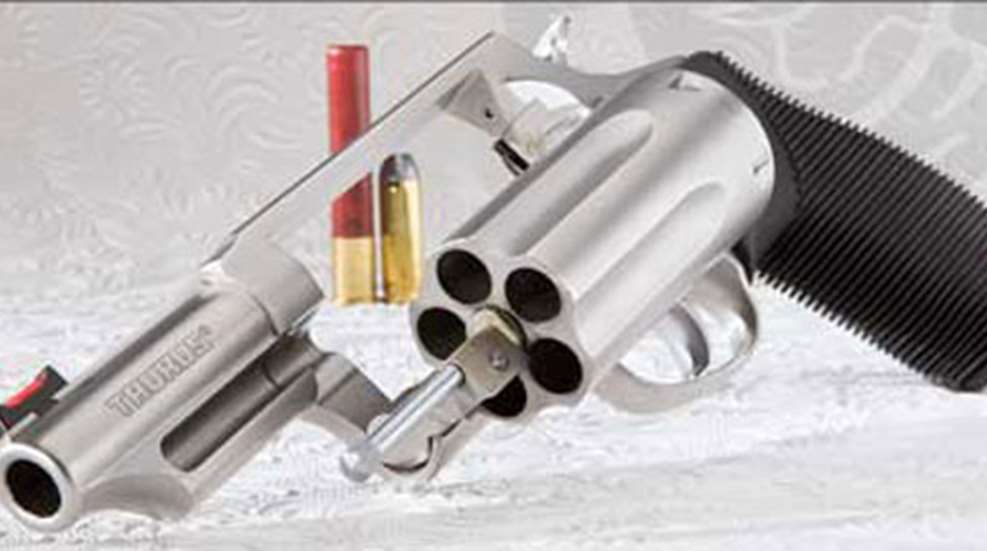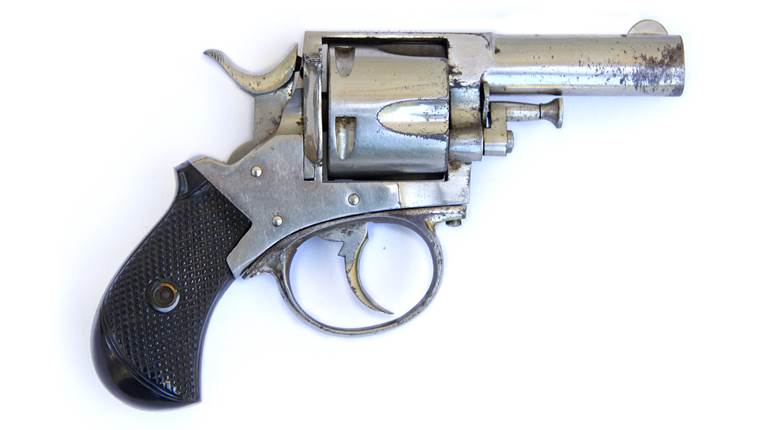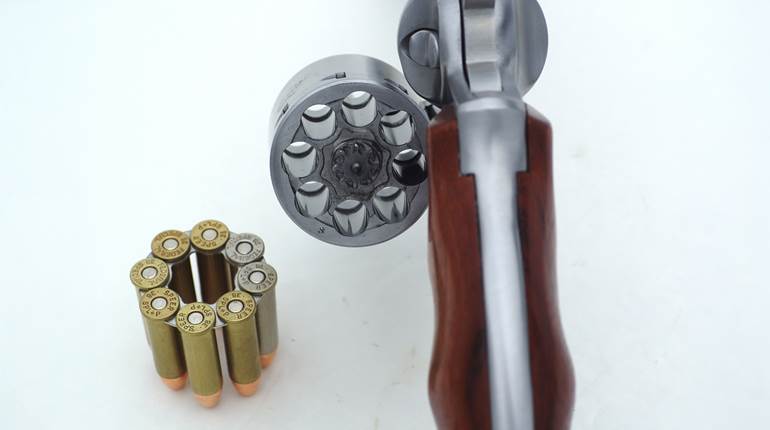
When we first looked at the Taurus Judge revolver (August 2007,p. 50), it was the gun's novelty value that drew our attention. After all, you don't often see a revolver that fires .45 Colt and .410 shotgun shells interchangeably. That first article sparked a great deal of reader interest, as indicated by quite a lot of mail. When the story ran, there were not a lot of the guns on dealers' shelves, and the available specimens sold briskly. In the intervening months, Taurus has worked to remedy the shortages and made its catalog's promise of more model variations a reality. In the 2008 listing of models, there are eight different Judge revolvers. Half of them differ only by way of their blued steel construction, and I had none of those for evaluation. I was able to secure an original model, its lightweight counterpart and the newest gun in the line. I didn't have the long-barreled (6 ½-inch) field revolver. The newest Judge revolver is one with an extra-length cylinder that accepts the longer 3-inch .410-bore shotshells.
For those who aren't aware of the Judge and the surprising interest American shooters have shown in it, let's take a quick look at the basics. The Judge is a dimensional variation of Taurus' compact-frame revolver, a medium-size wheelgun with a cylinder of such diameter that it accepts five rounds of .45 Colt. The difference between the Judge and other conventional revolvers is in the length of the cylinder, which is extended to an overall length of 2.69 inches (3.19 inches in the 3-inch variant). Naturally, the frame is also extended to provide a window long enough for either of these super cylinders. The extra length permits use of .410-bore shotgun shells in that long cylinder.
A conventional revolver in all other respects, the Judge comes with fixed sights and double-action single-action lockwork. It is deliberately contrived to shoot shotgun shells, but its short (usually) 3" barrel is rifled to keep the gun from falling under the provisions of the National Firearms Act as a short-barreled shotgun. With .45 Colt ammunition, the Judge is a good short-range conventional revolver. With .410 shotshells, it becomes a host of different things. It can be a varmint gun for use on dangerous pests, a sporting gun with clay pigeons or other thrown targets, a small-game gun in survival situations and—probably most significantly—a defensive revolver with decisive terminal ballistics.
Consider the potential of the Judge in terms of what it will deliver. This chunky revolver fires the complete array of .45 Colt ammunition, which includes all of the mild loads used in Cowboy Action competition and the somewhat hotter loads for modern revolvers. Although the company literature makes no mention of it, the Judge will also fire .45 Schofield (a.k.a. .45 S&W) ammunition, which is widely available for Cowboy match shooting.
The shallow rifling in the Judge’s barrel will stabilize typical .45 Colt bullets, but not to the degree possible with other Taurus .45 Colt guns. You can stay on a Bianchi Cup silhouette at 25 yds., but the group is not tight. As a shotgun, the Judge will take the entire range of 2 1/2" .410-bore shotshells. Shot sizes currently available include small stuff (Nos. 9, 8 and 7 1/2), mediums (Nos. 6 and 4), 000 buckshot and even a rifled slug (1/4 oz.). The selection broadens considerably if your Judge is one of the new ones with a longer cylinder that takes 3" shells. This longer gun can take the 000 buckshot load with five pellets. A single 000 pellet measures approximately 0.36" and weighs 70 to 72 grs. In my view, this is the preferred load for defensive shooting.
The guns have a push-forward cylinder latch and a swing-out cylinder that opens to the left. There’s a centrally mounted extractor rod with a star that engages the rims of the five cartridges in the chambers and lifts them free. Sights are likewise typical, with a square notch rear milled into the top of the frame and a fiber-optic front dovetailed into the barrel rib. The stubby barrel has a short underlug and a full-length sighting rib on top. A shooter can shoot with either the single-action trigger or the longer double-action—the Judge has both.
Since the gun has a primary role as a defensive revolver that might be carried on the person, Taurus put effort into minimizing the number of sharp edges and corners. This is very obvious in the cylinder latch, which is somewhat tear-drop shaped and nicely radiused on all sides. Acknowledging the potential for sharp recoil, the maker equipped the gun with a one-piece rubber grip section with small horizontal ribs molded in. It has the catchy name of “Ribber.”
I took the trio of Judge revolvers to the range with a supply of currently available commercial ammunition. Since the stainless steel Judge with 2 1/2" cylinder was fired for a previous story, I shot it only briefly to verify my impressions already reported. The lightweight Judge, which also has a 2 1/2" cylinder, has the same overall dimensions, but it is just about a half-pound lighter. This means that the gun produces recoil and muzzle rise that is noticeably greater, but still easily manageable. In view of the considerably greater ease in carrying the lighter gun, the greater trouble in shooting it is worth it. If you are going to carry one of these revolvers on your person, the light Judge is probably the way to go. The 3"-cylinder gun has so many terminal ballistic advantages that it quickly became my favorite.
A 3" weighs 37 ozs., which is just about the same as a M1911 .45 ACP pistol. That is no featherweight, but the gun performs very nicely indeed. Standard 3" .410 shells carry about 1 1/16 oz. of shot, as opposed to about 1/2 oz. in a 2 1/2"shell. In the case of both No. 4 and No. 6 loads, the velocity was slightly higher, but the patterns were much more even. I fired both loads at what I believe to be a reasonable maximum distance for destroying dangerous pests—5 yds. In both cases, the Caldwell Orange Peel targets showed even distribution of pellets, with very few outside the 12" by 18" scoring rings.
In my view, the Judge’s greatest utility comes as a defensive revolver. I thought that before the 3" version was available, and my opinion was reinforced with the availability of the longer gun. A long Judge will chamber a 000 load that delivers five pellets. At 70 grs., that would total 350 grs. of payload averaging 808 f.p.s. from the Judge’s short snout. That equates to 508 ft.-lbs of energy. A single hit from a standard 230-gr. .45 ACP load is about 370 ft.-lbs. Also a centered hit from the five 000 pellets would impact over a larger area and produce five individual wound channels. I fired a series of four targets with this load at short combat distances (3,5,7 and 9 yds.) and got increasingly larger groups of about 3", 6", 7" and 12", respectively. Beyond 9 to 10 yds., the groups opened up abruptly, and I often lost one of more pellets off the silhouette laterally. At close range, a single centered hit from the Judge (with 000) would be devastating. For longer ranges, the revolver cylinder offers the interesting possibility of pattern loading. You might try the first three chambers with 000 buckshot and the last two with .45 Colt lead semi-wadcutter hollow-points in the event that a target appears at a greater range.
There is flexibility inherent in a revolver design and, in my estimation, the Judge is the most versatile combat revolver since the LeMat of the Civil War era. It’s a load to carry and a handful to shoot, but the Judge is a powerful solution to the defense gun needs of many shooters.





































